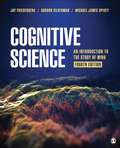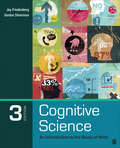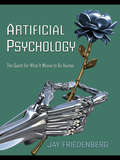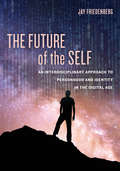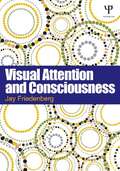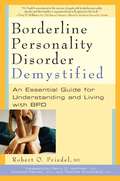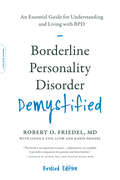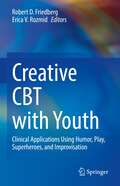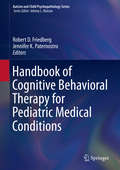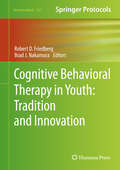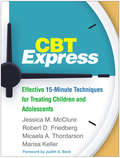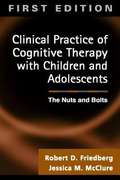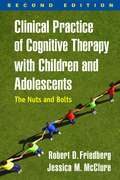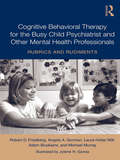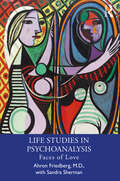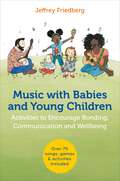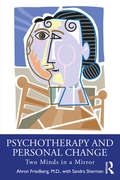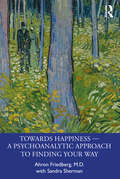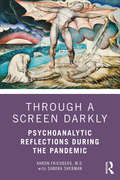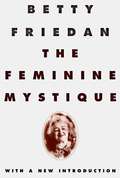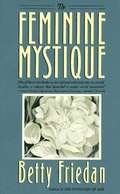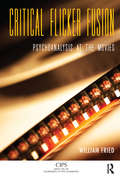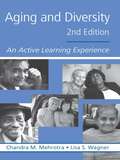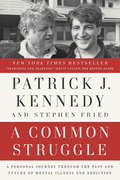- Table View
- List View
Cognitive Science: An Introduction to the Study of Mind
by Jay D. Friedenberg Gordon W. Silverman Michael J. SpiveyCognitive Science provides a comprehensive and up-to-date introduction to the study of the mind. The authors examine the mind from the perspective of different fields, including philosophy, psychology, neuroscience, networks, evolution, emotional and social cognition, linguistics, artificial intelligence, robotics, and the new framework of embodied cognition. Each chapter focuses on a particular disciplinary approach and explores methodologies, theories, and empirical findings. Substantially updated with new and expanded content, the Fourth Edition reflects the latest research in this rapidly evolving field.
Cognitive Science: An Introduction to the Study of Mind
by Jay D. Friedenberg Dr Gordon W. SilvermanIn Cognitive Science 3e Friedenberg and Silverman provide a solid understanding of the major theoretical and empirical contributions of cognitive science. Their text, thoroughly updated for this new third edition, describes the major theories of mind as well as the major experimental results that have emerged within each cognitive science discipline. Throughout history, different fields of inquiry have attempted to understand the great mystery of mind and answer questions like: What is the mind? How do we see, think, and remember? Can we create machines that are conscious and capable of self-awareness? This books examines these questions and many more. Focusing on the approach of a particular cognitive science field in each chapter, the authors describe its methodology, theoretical perspective, and findings and then offer a critical evaluation of the field. Features: Offers a wide-ranging, comprehensive, and multidisciplinary introduction to the field of cognitive science and issues of mind. Interdisciplinary Crossroads” sections at the end of each chapter focus on research topics that have been investigated from multiple perspectives, helping students to understand the link between varying disciplines and cognitive science. End-of-chapter “Summing Up” sections provide a concise summary of the major points addressed in each chapter to facilitate student comprehension and exam preparation “Explore More” sections link students to the Student Study Site where the authors have provided activities to help students more quickly master course content and prepare for examinations Supplements: A password-protected Instructor’s Resource contains PowerPoint lectures, a test bank and other pedagogical material.The book's Study Site features Web links, E-flash cards, and interactive quizzes.
Cognitive Science: An Introduction to the Study of Mind
by Jay D. Friedenberg Dr Gordon W. SilvermanIn Cognitive Science 3e Friedenberg and Silverman provide a solid understanding of the major theoretical and empirical contributions of cognitive science. Their text, thoroughly updated for this new third edition, describes the major theories of mind as well as the major experimental results that have emerged within each cognitive science discipline. Throughout history, different fields of inquiry have attempted to understand the great mystery of mind and answer questions like: What is the mind? How do we see, think, and remember? Can we create machines that are conscious and capable of self-awareness? This books examines these questions and many more. Focusing on the approach of a particular cognitive science field in each chapter, the authors describe its methodology, theoretical perspective, and findings and then offer a critical evaluation of the field. Features: Offers a wide-ranging, comprehensive, and multidisciplinary introduction to the field of cognitive science and issues of mind. Interdisciplinary Crossroads” sections at the end of each chapter focus on research topics that have been investigated from multiple perspectives, helping students to understand the link between varying disciplines and cognitive science. End-of-chapter “Summing Up” sections provide a concise summary of the major points addressed in each chapter to facilitate student comprehension and exam preparation “Explore More” sections link students to the Student Study Site where the authors have provided activities to help students more quickly master course content and prepare for examinations Supplements: A password-protected Instructor’s Resource contains PowerPoint lectures, a test bank and other pedagogical material.The book's Study Site features Web links, E-flash cards, and interactive quizzes.
Artificial Psychology: The Quest for What It Means to Be Human
by Jay FriedenbergIs it possible to construct an artificial person? Researchers in the field of artificial intelligence have for decades been developing computer programs that emulate human intelligence. This book goes beyond intelligence and describes how close we are to recreating many of the other capacities that make us human. These abilities include learning, creativity, consciousness, and emotion. The attempt to understand and engineer these abilities constitutes the new interdisciplinary field of artificial psychology, which is characterized by contributions from philosophy, cognitive psychology, neuroscience, computer science, and robotics. This work is intended for use as a main or supplementary introductory textbook for a course in cognitive psychology, cognitive science, artificial intelligence, or the philosophy of mind. It examines human abilities as operating requirements that an artificial person must have and analyzes them from a multidisciplinary approach. The book is comprehensive in scope, covering traditional topics like perception, memory, and problem solving. However, it also describes recent advances in the study of free will, ethical behavior, affective architectures, social robots, and hybrid human-machine societies.
The Future of the Self: An Interdisciplinary Approach to Personhood and Identity in the Digital Age
by Jay FriedenbergWe live in the digital age where our sense of self and identity has moved beyond the body to encompass hardware and software. Cyborgs, online representations in social media, avatars, and virtual reality extend our notion of what it means to be human. This book looks at the progression of self from the biological to the technological using a multidisciplinary approach. It examines the notion of personhood from philosophical, psychological, neuroscience, robotics, and artificial intelligence perspectives, showing how the interface between bodies, brains, and technology can give rise to new forms of human identity. Jay Friedenberg presents the content in an organized and easy-to-understand fashion to facilitate learning. A gifted researcher, author, and classroom teacher, he is one of the most influential voices in the field of artificial psychology.
Visual Attention and Consciousness
by Jay FriedenbergConsciousness is perhaps one of the greatest mysteries in the universe. This ambitious book begins with a philosophical approach to consciousness, examining some key questions such as what is meant by the term "conscious," and how this applies to vision. The book then explores major visual phenomena related to attention and conscious experience—including filling-in processes, aftereffects, multi-stability, forms of divided attention, models of visual attention, priming effects, types of attentional blindness and various visual disorders. For each phenomenon, the biological and cognitive level research is reviewed. Themes touched upon throughout are the relation between consciousness and attention, automatic vs. willful processes, singularity vs. multiplicity, and looking without seeing. The book concludes with an evolutionary approach, describing possible functions that visual consciousness may serve and how those may affect the way we see. The systematic review of key topics and the multitude of perspectives make this book an ideal primary or ancillary text for graduate courses in perception, vision, consciousness, or philosophy of mind.
Borderline Personality Disorder Demystified
by Robert O. Friedel Foreword by Perry D. Hoffman Dixianne Penney Patricia WoodwardOver six million Americans suffer from Borderline Personality Disorder (BPD), a chronic, disabling psychiatric condition that causes extreme instability in their emotional lives, behavior, and self-image, and severely impacts their family and friends. In Borderline Personality Disorder Demystified, Dr. Robert Friedel, a leading expert in BPD and a pioneer in its treatment, has turned his vast personal experience into a useful and supportive guide for everyone living with and seeking to understand this condition. Friedel helps readers grasp the etiology of Borderline Personality Disorder, the course it takes, the difficulties in diagnosing it, the types of treatment available, strategies for coping, and much more. Borderline Personality Disorder Demystified is an invaluable resource for everyone diagnosed with BPD, those who think they might have the illness, and friends and family who love and support them.
Borderline Personality Disorder Demystified, Revised Edition: An Essential Guide for Understanding and Living with BPD (Demystified)
by Robert O. Friedel Linda F. CoxThe authoritative guide to understanding and living with borderline personality disorder, now fully revised and updated Millions of Americans suffer from borderline personality disorder (BPD), a psychiatric condition marked by extreme emotional instability, erratic and self-destructive behavior, and tumultuous relationships. Though it was once thought to be untreatable, today researchers and clinicians know that there is every reason for hope. Dr. Robert Friedel, a leading expert and pioneer in pharmacological treatment for BPD, combines his extensive knowledge and personal experience into this comprehensive guide. Borderline Personality Disorder Demystified shares: The latest findings on the course and causes of the disorder Up-to-date information on diagnosis An accessible overview of cutting-edge treatment options For those who have been diagnosed and those who think they may have the illness, and for the family and friends who love and support them, this book illuminates new information and points the way to an ever more hopeful future. The revised edition includes new forewords from Donald W. Black, MD, and Nancee S. Blum, MSW, and family educators James and Diane Hall.
Creative CBT with Youth: Clinical Applications Using Humor, Play, Superheroes, and Improvisation
by Robert D. Friedberg Erica V. RozmidThis book combines empirical support, clinical acumen, and practical recommendations in a comprehensive manner to examine creative augmentations to the robust cognitive behavioral therapy (CBT) model. It discusses augmentations that are supported by research and practice and are also clinical-friendly tools. Each chapter briefly summarizes research findings, offers parsimonious explanations of theoretical concepts and principles, presents vivid descriptions of therapeutic procedures, and describes rich case illustrations. The book addresses the use of humor in CBT with youth, playful applications of CBT, applications of improvisational theatre in CBT and integrating superheroes into CBT. Key areas of coverage include: Building stronger, more flexible, and enduring alliances with children and adolescents to improve treatment retention and impact. Using humor and irreverent communication in dialectical behavior therapy (DBT) to enhance outcomes with adolescents. Developing rapport between medical and psychosocial team members to alleviate stress during pediatric medical procedures and as an adjunct to therapeutic interventions. Cognitive behavioral play therapy (CBPT) with young children. Family-focused CBT for pediatric OCD (obsessive-compulsive disorder). Cognitive Behavioral Psychodrama Group Therapy (CBPGT) with youth. This unique and compelling volume is an authoritative resource for researchers, professors, clinicians, therapists and other professionals as well as graduate students in developmental psychology, pediatrics, social work, child and adolescent psychiatry, and nursing.
Handbook of Cognitive Behavioral Therapy for Pediatric Medical Conditions (Autism and Child Psychopathology Series)
by Robert D. Friedberg Jennifer K. PaternostroThis handbook offers a comprehensive review of cognitive behavioral therapy (CBT) for working in integrated pediatric behavioral health care settings. It provides research findings, explanations of theoretical concepts and principles, and descriptions of therapeutic procedures as well as case studies from across broad conceptual areas. Chapters discuss the value of integrated care, diversity issues, ethical considerations, and the necessary adaptations. In addition, chapters address specific types of pediatric conditions and patients, such as the implementation of CBT with patients with gastrointestinal complaints, enuresis, encopresis, cancer, headaches, epilepsy, sleep problems, diabetes, and asthma. The handbook concludes with important directions in research and practice, including training and financial considerations.Topics featured in this handbook include: Emotional regulation and pediatric behavioral health problems. Dialectical Behavior Therapy (DBT) for pediatric medical conditions. Pharmacological interventions and the combined use of CBT and medication. CBT in pediatric patients with chronic pain. CBT for pediatric obesity. CBT-informed treatments and approaches for transgender and gender expansive youth.Medical non-compliance and non-adherence associated with CBT.Training issues in pediatric psychology. The Handbook of Cognitive Behavioral Therapy for Pediatric Medical Conditions is an essential resource for researchers and graduate students as well as clinicians, related therapists, and professionals in clinical child and school psychology, pediatrics, social work, developmental psychology, behavioral therapy/rehabilitation, child and adolescent psychiatry, nursing, and special education.
Cognitive Behavioral Therapy in Youth: Tradition and Innovation (Neuromethods #156)
by Robert D. Friedberg Brad J. NakamuraThis volume discusses the proper applications of cognitive behavioral theory (CBT) to common clinical presentations. This book represents both the traditions and advances within the broad CBT field. Chapters in this book cover topics such as CBT with depressed youth; CBT for pediatric OCD; CBT with eating disordered youth; modular CBT for youth, and transdiagnostic treatment of emotional disorders in children and adolescents. In Neuromethods series style, chapters include the kind of detail and key advice from the specialists needed to get successful results in your laboratory.Cutting-edge and practical, Tradition and Innovation in Cognitive Behavioral Therapy in Youth is a valuable resource that inspires and encourages readers to use the practices discussed in this book as their own.
CBT Express: Effective 15-Minute Techniques for Treating Children and Adolescents
by Robert D. Friedberg Jessica M. McClure Micaela A. Thordarson Marisa KellerOffering vital tools for working with 4- to 18-year-olds in a wide range of settings, this book presents engaging cognitive-behavioral therapy (CBT) activities that can be implemented rapidly and flexibly. Concise chapters guide the provider to quickly identify meaningful points of intervention for frequently encountered clinical concerns, and to teach and model effective strategies. Each intervention includes a summary of the target age, module, purpose, rationale, materials needed, and expected time for completion, as well as clear instructions and sample dialogues and scripts. In a convenient large-size format, the book features helpful graphics and 77 reproducible handouts and worksheets in the form of Handy and Quick (HQ) Cards. Purchasers get access to a Web page where they can download and print the reproducible materials.
Clinical Practice of Cognitive Therapy with Children and Adolescents: The Nuts and Bolts
by Robert D. Friedberg Jessica M. McclureTaking into account developmental issues and working with parents, this guide applies Aaron T. Beck's clinical system of cognitive therapy based on social learning theory to younger clients. Cognitive therapists Friedberg and McClure (both at Wright State U. School of Professional Psychology) present commonly used cognitive/behavioral techniques and child-friendly treatment strategies tailored to depressed, anxious, and aggressive youth. They include case examples and sample worksheets. Annotation c. Book News, Inc. , Portland, OR (booknews. com)
Clinical Practice of Cognitive Therapy with Children and Adolescents, Second Edition
by Robert D. Friedberg Jessica M. McclureWidely regarded as the definitive practitioner reference and teaching text, this book provides a complete introduction to doing cognitive-behavioral therapy (CBT) with 6- to 18-year-olds. The authors offer a blueprint for formulating cases and tailoring treatment to each child's or adolescent's unique developmental and clinical needs. Coverage includes how to orient children and families to cognitive therapy, structure each session, and implement a wide range of CBT techniques. Rich case material illustrates ways that CBT can help children struggling with specific emotional and behavioral problems. Reproducible forms and handouts can be downloaded and printed in a convenient 8 1/2" x 11" size. New to This Edition *Incorporates the latest advances in CBT with youth and gives increased attention to cultural issues, including new case examples. *Chapter on working with patients with autism spectrum disorder. *Chapter on cognitive-behavioral family therapy. *Pull-out boxes throughout that summarize key points. *Epilogue on developing clinical wisdom. See also the authors' Cognitive Therapy Techniques for Children and Adolescents: Tools for Enhancing Practice, which presents creative ways to address challenging problems.
Cognitive Behavioral Therapy for the Busy Child Psychiatrist and Other Mental Health Professionals: Rubrics and Rudiments
by Robert D. Friedberg Angela A. Gorman Laura Hollar Wilt Adam Biuckians Michael MurrayCognitive Behavioral Therapy for the Busy Child Psychiatrist and Other Mental Health Professionals is an essential resource for clinical child psychologists, psychiatrists and psychotherapists, and mental health professionals. Since 2001, psychiatry residency programs have required resident competency in five specific psychotherapies, including cognitive-behavioral therapy. This unique text is a guidebook for instructors and outlines fundamental principles, while offering creative applications of technique to ensure that residency training programs are better equipped to train their staff.
Life Studies in Psychoanalysis: Faces of Love
by Ahron Friedberg, M.D. Sandra ShermanLife Studies in Psychoanalysis consists of four psychoanalytic studies, each representing a patient’s course of treatment over several years. These studies demonstrate how love, in an array of forms, is refracted through the process of psychoanalysis, which unfolds over time and reveals the complexities of human desire. The cases presented here cover topics including repressed homosexuality, a taboo desire for a sibling, obsession with a fantasy, an Oedipus complex, and transferences that become an initial obstacle to treatment. As the studies proceed, each renders the nonlinear progress of treatment, as layer upon layer of a patient’s issues are brought to light and the patient slowly, often reluctantly, comes to terms with these issues. Dr. Ahron Friedberg offers professionals techniques for encouraging patients to remain in treatment when they become resistant, demoralized, or feel like they have hit a wall. Ultimately, this book demonstrates how some patients, troubled by romantic, sexualized, fantasized, illicit, and/or uncontrollable desire, learn through psychoanalysis to accommodate their desires to what is possible and permissible in the lives that they otherwise inhabit. In this sense, the studies involve journeys from a place characterized by the epiphenomena of troubled love – grief, guilt, frustration – to one in which, through enhanced self-awareness, patients understand the sources and implications of their motivations. They come to understand why love has seemed like a minefield, and begin to find a more fulfilling path through it. Life Studies in Psychoanalysis will be of great interest to psychoanalysts in practice and in training, psychoanalytic psychotherapists, and readers looking for insight into the analytic process.
Music with Babies and Young Children: Activities to Encourage Bonding, Communication and Wellbeing
by Jeffrey FriedbergFrom day one in a child's life, music is one of the most important things that can be used to help them grow and learn. Musical stimulation helps lay the foundations for a lifetime of skills, and this straightforward guide gives detailed advice on how to use music to help children from 0-5 years with common developmental challenges such as attachment and bonding, bedtime, tantrums and daily living skills, social skills, motor skills and school readiness. Combining cutting-edge research on brain development with proven strategies, this book helps with both typical and atypical issues in the earliest stages of a child's life. Friedberg lays out the musical parenting approach, where any adult can enhance children's lives through music. No prior music skill is necessary to use the musical parenting approach, making it an ideal resource for all parents, teachers and professionals to raise healthy, well-adjusted children in a creative and interactive manner.
Psychotherapy and Personal Change: Two Minds in a Mirror
by Ahron Friedberg Sandra ShermanPsychotherapy and Personal Change: Two Minds in a Mirror offers unique day-to-day accounts of patients undergoing psychotherapy and what happens during "talk therapy" to startle the complacent, conscious mind and expose the unconscious. It is a candid, moment-by-moment revelation of how the therapist’s own memories, feelings, and doubts are often as much a factor in the process as those of the patient. In the process of healing, both the therapist and the patient reflect on each other and on themselves. As the therapist develops empathy for the patient, and the patient develops trust in the therapist, their shared memories, feelings, and associations interact and entwine – almost kaleidoscopically – causing each to ask questions of the other and themselves. In this book, Dr. Friedberg reveals personal insights that arose as he recalled memories to share with patients. These insights might not have arisen but for the therapy, which operates in multiple directions as patient and therapist explore the present, the past, and the unknown. Readers will see the therapist – like the patient – as a complex, vulnerable human being influenced by parents, colleagues, and friends, whose conscious and unconscious minds ramify through each other. It is a truism of psychotherapy that in order to commit to the process, whatever the reservations or misconceptions, one must understand that therapy is not passive. The patient must expect to become personally involved with the therapist. The patient learns about the therapist even as the therapist helps the patient to gain insight into him- or herself. Psychotherapy and Personal Change shows how this exchange develops and how each actor is affected. Through specific examples, the book raises the reader’s understanding of what to expect from psychotherapy and enhances his/her insight into therapy that he or she may have had already.
Towards Happiness — A Psychoanalytic Approach to Finding Your Way
by Ahron Friedberg Sandra ShermanDrawing on a range of clinical cases, Towards Happiness presents an engaging, insightful look at how we define and achieve happiness in core aspects of our lives: work and money, wellness and personal growth, sex and love, family and friendship, and aging. The book includes a series of essays by Dr. Ahron Friedberg, a prominent Manhattan psychiatrist, concerning how his patients sought to achieve greater happiness during challenging periods of their lives, and how as a consequence they grew personally and professionally. Each chapter considers a core topic through the lens of Dr. Friedberg’s practice, demonstrating how patients worked through difficult, sometimes chronic personal issues. Throughout, there are useful summaries of key points. While candidly acknowledging that each life is different, Towards Happiness offers practical examples that can enhance readers’ efforts to achieve greater levels of happiness and reorient their lives towards a deeper capacity for happiness. Towards Happiness offers honest insights into the compromises, sacrifices, and resulting degrees of success that characterize pursuing happiness, and will be of great interest to psychoanalysts, clinical psychologists, and other mental health professionals. It will also be useful reading for anyone seeking to understand the achievement of happiness in their own lives.
Through a Screen Darkly: Psychoanalytic Reflections During the Pandemic
by Ahron FriedbergThis book offers real-time, intimate reflections on Dr. Friedberg’s patients as they struggle with COVID-19 and its disruptive, dispiriting fallout. Through a Screen Darkly identifies the psychological distress caused by the pandemic, examining how the particular elements of COVID-19 – its ability to be spread by those who seem not to have it, its intractability, the long-term uncertainty that it engenders – leave even relatively stable people shaken and unsure of the future. The book examines how, amidst radical uncertainty and the prospect of massive social change, such people learn to become resilient. The main theme of the book is that, of necessity, we learn to adapt. Though we still can only see "darkly," we can call on the resources that we have, as well as those we can reasonably acquire, so as to retain a sense of our dignity and purpose. Through a Screen Darkly examines what is possible now as the pandemic runs its course. It makes no predictions of how all this will ultimately play out, but offers a time capsule of how people have coped with a disease that landed suddenly and that we still do not fully understand. Offering a series of intense encounters with worried, traumatized people, this book will be invaluable to in-training and practicing psychiatrists, as it points to the several possible directions for our national, psychological recovery from the pandemic.
The Feminine Mystique
by Betty Friedan Anna QuindlenThe book that changed the consciousness of a country -- and the world. "The Feminine Mystique", is the book that defined "the problem that has no name", and that launched the Second Wave of the feminist movement, and has been awakening women and men with its insights into social relations, which still remain fresh, ever since.
The Feminine Mystique
by Betty FriedanFirst published in 1963, "The Feminine Mystique" ignited a revolution that profoundly changed our culture, our consciousness, and our lives. Today it newly penetrates to the heart of issues determining our lives -- and sounds a call to arms against the very real dangers of a new feminine mystique in the economic and political turbulence of the 1990s. Three decades later, the underlying issues raised by Betty Friedan strike at the core of the problems women still face at home and in the marketplace. As women continue to struggle for equality, to keep their hard-won gains, to find fulfillment in their careers, marriage and family, "The Feminine Mystique" remains the seminal consciousness-raising work of our times.
Critical Flicker Fusion: Psychoanalysis at the Movies (CIPS (Confederation of Independent Psychoanalytic Societies) Boundaries of Psychoanalysis)
by William FriedThe premise of this book is that films, like other works of the imagination, may be elucidated by applying methods derived from psychoanalysis, and that doing so will result in a deeper and richer appreciation of the film's meaning. The book explores a number of feature films that lend themselves particularly well to this process. Both in his introduction and throughout the text, the author comments on the method and discusses continuities, similarities and differences among the films. The book is structured according to the central themes of the films, including time and death, love and lust, secrets, and human identity. Some of the films are relevant to more than one of these thematic elements. The introductory essay explores the themes, their representation in the films, and the ways in which they may be elucidated by a psychoanalytically informed critique. Brief paragraphs between the sections of the book facilitate the transitions. In an appendix, there are three essays titled 'Mise-en-scene,' 'Whatever Flames Upon the Night,' and 'Mad Doctors.'
Aging and Diversity
by Stephen Fried Lisa S. Wagner Chandra M. MehrotraThis new edition has been completely rewritten and includes chapters that address key topics in diversity and aging: research methods, psychological aging; health beliefs, behaviors, and services; health disparities; informal and formal care for older persons; work and retirement; religious affiliation and spirituality; and death, dying, and bereavement. Taking a broad view of diversity, Mehrotra and Wagner discuss elements of diversity such as gender, race or ethnicity, religious affiliation, social class, rural-urban community location and sexual orientation. Including these elements allows them to convey some of the rich complexities of our diverse culture - complexities that provide both challenges to meet the needs of diverse population and opportunities to learn how to live in a pluralistic society. Throughout the book, Mehrotra and Wagner present up-to-date knowledge and scholarship in a way that engages readers in active learning. Rather than simply transmitting information, the authors place ongoing emphasis on developing readers' knowledge and skills; fostering higher order thinking and encouraging exploration of personal values and attitudes. Distinctive features of the book include: Opening vignettes for each chapter that present a sampling of how the issues to be discussed apply to diverse elders. Active learning experiences that invite readers to interview diverse elders, conduct internet searches, and give an analysis of a case study. Quizzes at the end of the chapters help readers ascertain the extent to which they have learned the material; the key for each quiz includes details about correct and incorrect responses so that additional learning can occur. Aging and Diversity Online boxes interspersed throughout the book provide internet resources that readers may use to find new research and publications. Suggested readings and audiovisual resources given at the end of each chapter serve as a guide to additional information on topics covered in the chapter. This approach of presenting the material will help the readers understand and apply key concepts and principles in ways that will not only improve the lives of older people they serve, but will also enhance their own aging experience.
A Common Struggle: A Personal Journey Through the Past and Future of Mental Illness and Addiction
by Stephen Fried Patrick J. Kennedy**A New York Times Bestseller**Patrick J. Kennedy, the former congressman and youngest child of Senator Ted Kennedy, details his personal and political battle with mental illness and addiction, exploring mental health care's history in the country alongside his and every family's private struggles.On May 5, 2006, the New York Times ran two stories, "Patrick Kennedy Crashes Car into Capitol Barrier" and then, several hours later, "Patrick Kennedy Says He'll Seek Help for Addiction." It was the first time that the popular Rhode Island congressman had publicly disclosed his addiction to prescription painkillers, the true extent of his struggle with bipolar disorder and his plan to immediately seek treatment. That could have been the end of his career, but instead it was the beginning. Since then, Kennedy has become the nation's leading advocate for mental health and substance abuse care, research and policy both in and out of Congress. And ever since passing the landmark Mental Health Parity and Addiction Equity Act--and after the death of his father, leaving Congress--he has been changing the dialogue that surrounds all brain diseases.A Common Struggle weaves together Kennedy's private and professional narratives, echoing Kennedy's philosophy that for him, the personal is political and the political personal. Focusing on the years from his 'coming out' about suffering from bipolar disorder and addiction to the present day, the book examines Kennedy's journey toward recovery and reflects on Americans' propensity to treat mental illnesses as "family secrets."Beyond his own story, though, Kennedy creates a roadmap for equality in the mental health community, and outlines a bold plan for the future of mental health policy. Written with award-winning healthcare journalist and best-selling author Stephen Fried, A Common Struggle is both a cry for empathy and a call to action. From the Hardcover edition.
